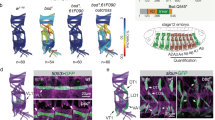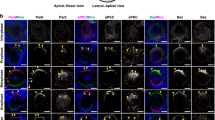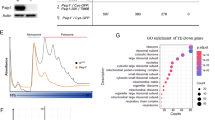Abstract
Par-1 kinase is critical for polarization of the Drosophila melanogaster oocyte and the one-cell Caenorhabditis elegans embryo. Although Par-1 localizes specifically to the posterior pole in both cells, neither its targets nor its function at the posterior pole have been elucidated. Here we show that Drosophila Par-1 phosphorylates the posterior determinant Oskar (Osk) and demonstrate genetically that Par-1 is required for accumulation of Osk protein. We show in cell-free extracts that Osk protein is intrinsically unstable and that it is stabilized after phosphorylation by Par-1. Our data indicate that posteriorly localized Par-1 regulates posterior patterning by stabilizing Osk.
This is a preview of subscription content, access via your institution
Access options
Subscribe to this journal
Receive 12 print issues and online access
$209.00 per year
only $17.42 per issue
Buy this article
- Purchase on Springer Link
- Instant access to full article PDF
Prices may be subject to local taxes which are calculated during checkout







Similar content being viewed by others
References
Guo, S. & Kemphues, K. J. par-1, a gene required for establishing polarity in C. elegans embryos, encodes a putative Ser/Thr kinase that is asymmetrically distributed. Cell 81, 611–620 (1995).
Shulman, J. M., Benton, R. & St Johnston, D. The Drosophila homolog of C. elegans PAR-1 organizes the oocyte cytoskeleton and directs oskar mRNA localization to the posterior pole. Cell 101, 377–388 (2000).
Tomancak, P. et al. A Drosophila melanogaster homologue of Caenorhabditis elegans par-1 acts at an early step in embryonic-axis formation. Nature Cell Biol. 2, 458–460 (2000).
Cox, D. N., Lu, B., Sun, T.-S., Williams, L. T. & Jan, Y. N. Drosophila par-1 is required for oocyte differentiation and microtubule organization. Curr. Biol. 11, 75–87 (2001).
Huynh, J.-R., Shulman, J., Benton, R. & St Johnston, D. Par-1 is required for the maintenance of oocyte fate in Drosophila. Development 128, 1201–1209 (2001).
Drewes, G., Ebneth, A., Preuss, U., Mandelkow, E. M. & Mandelkow, E. MARK, a novel family of protein kinases that phosphorylate microtubule- associated proteins and trigger microtubule disruption. Cell 89, 297–308 (1997).
Markussen, F. H., Michon, A. M., Breitwieser, W. & Ephrussi, A. Translational control of oskar generates short OSK, the isoform that induces pole plasma assembly. Development 121, 3723–3732 (1995).
Rongo, C., Gavis, E. R. & Lehmann, R. Localization of oskar RNA regulates oskar translation and requires Oskar protein. Development 121, 2737–46 (1995).
Kim-Ha, J., Kerr, K. & Macdonald, P. M. Translational regulation of oskar mRNA by Bruno, an ovarian RNA-binding protein, is essential. Cell 81, 403–412 (1995).
Webster, P. J., Liang, L., Berg, C. A., Lasko, P. & Macdonald, P. M. Translational repressor Bruno plays multiple roles in development and is widely conserved. Genes Dev 11, 2510–2521 (1997).
Gunkel, N., Yano, T., Markussen, F. H., Olsen, L. C. & Ephrussi, A. Localization-dependent translation requires a functional interaction between the 5′ and 3′ ends of oskar mRNA. Genes Dev. 12, 1652–1664 (1998).
Ephrussi, A. & Lehmann, R. Induction of germ cell formation by oskar. Nature 358, 387–392 (1992).
Smith, J. L., Wilson, J. E. & Macdonald, P. M. Overexpression of oskar directs ectopic activation of nanos and presumptive pole cell formation in Drosophila embryos. Cell 70, 849–859 (1992).
Ephrussi, A., Dickinson, L. K. & Lehmann, R. Oskar organizes the germ plasm and directs localization of the posterior determinant nanos. Cell 66, 37–50 (1991).
Kim-Ha, J., Smith, J. L. & Macdonald, P. M. oskar mRNA is localized to the posterior pole of the Drosophila oocyte. Cell 66, 23–35 (1991).
Hay, B., Jan, L. Y. & Jan, Y. N. Localization of vasa, a component of Drosophila polar granules, in maternal-effect mutants that alter embryonic anteroposterior polarity. Development 109, 425–433 (1990).
Lasko, P. F. & Ashburner, M. Posterior localization of Vasa protein correlates with, but is not sufficient for, pole cell development. Genes Dev. 4, 905–921 (1990).
Breitwieser, W., Markussen, F. H., Horstmann, H. & Ephrussi, A. Oskar protein interaction with Vasa represents an essential step in polar granule assembly. Genes Dev. 10, 2179–2188 (1996).
Markussen, F. H., Breitwieser, W. & Ephrussi, A. Efficient translation and phosphorylation of Oskar require Oskar protein and the RNA helicase Vasa. Cold Spring Harb. Symp. Quant. Biol. 62, 13–17 (1997).
St Johnston, D., Brown, N. H., Gall, J. G. & Jantsch, M. A conserved double-stranded RNA-binding domain. Proc. Natl Acad. Sci. USA 89, 10979–10983 (1992).
Lasko, P. RNA sorting in Drosophila oocytes and embryos. FASEB J. 13, 421–433 (1999).
Fuchs, S. Y., Fried, V. A. & Ronai, Z. Stress-activated kinases regulate protein stability. Oncogene 17, 1483–1490 (1998).
St Johnston, D., Beuchle, D. & Nüsslein-Volhard, C. staufen, a gene required to localize maternal RNAs in the Drosophila egg. Cell 66, 51–63 (1991).
Kemphues, K. PARsing embryonic polarity. Cell 101, 345–348 (2000).
Boyd, L., Guo, S., Levitan, D., Stinchcomb, D. T. & Kemphues, K. J. PAR-2 is asymmetrically distributed and promotes association of P granules and PAR-1 with the cortex in C. elegans embryos. Development 122, 3075–3084 (1996).
Bowerman, B., Ingram, M. K. & Hunter, C. P. The maternal par genes and the segregation of cell fate specification activities in early Caenorhabditis elegans embryos. Development 124, 3815–3826 (1997).
Rørth, P. Gal4 in the Drosophila female germline. Mech. Dev. 78, 113–118 (1998).
Murray, A. W. & Kirschner, M. W. Cyclin synthesis drives the early embryonic cell cycle. Nature 339, 275–280 (1989).
Acknowledgements
We thank F. Senger, A. Pozniakovsky and R. Lippe for help during purification of recombinant Par-1 protein, A. Jenny for providing Osk protein and antibody, O. Coux for GST-Ubiquitin, N. Gunkel for generation of UAS-par-1 transgenes and T. Vaccari, P. Gönczy and K. Kemphues for comments on the manuscript. We are grateful to P. Tomancak for valuable ideas and discussions. V. R. was supported by EMBO fellowship ALTF 508-1998.
Author information
Authors and Affiliations
Supplementary information
Rights and permissions
About this article
Cite this article
Riechmann, V., Gutierrez, G., Filardo, P. et al. Par-1 regulates stability of the posterior determinant Oskar by phosphorylation. Nat Cell Biol 4, 337–342 (2002). https://doi.org/10.1038/ncb782
Received:
Revised:
Accepted:
Published:
Issue Date:
DOI: https://doi.org/10.1038/ncb782
This article is cited by
-
The PIWI protein Aubergine recruits eIF3 to activate translation in the germ plasm
Cell Research (2020)
-
Mark4
AfCS-Nature Molecule Pages (2006)
-
Mark1
AfCS-Nature Molecule Pages (2006)
-
Proteolysis: anytime, any place, anywhere?
Nature Cell Biology (2005)
-
Molecular Mechanisms of Germ Line Cell Determination in Animals
Molecular Biology (2005)



